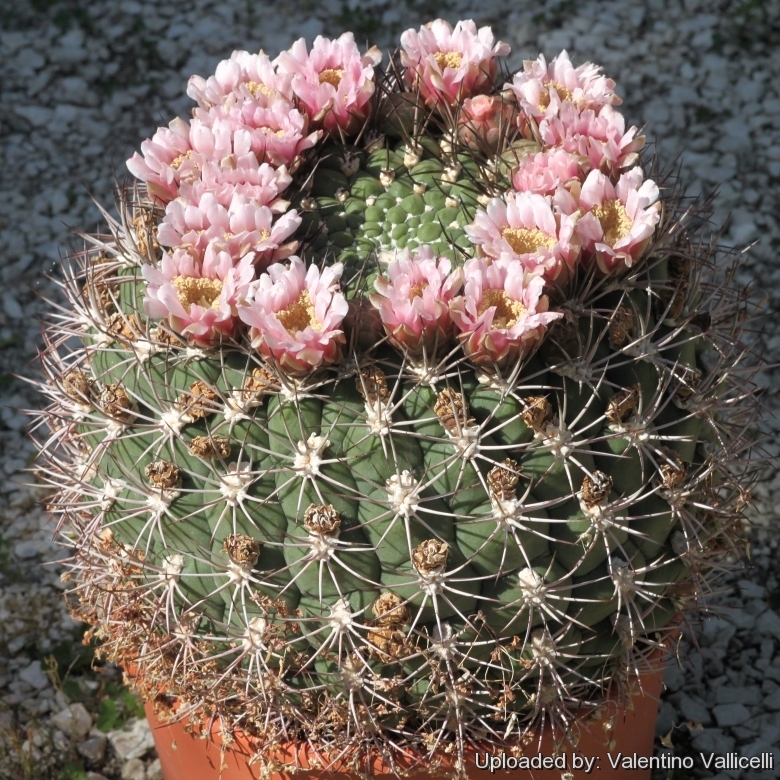
Gymnocalycium saglionis Photo by: Valentino Vallicelli
Origin and Habitat: Gymnocalycium saglionisSN|12116]]SN|12116]] has a wide range and is locally abundant in Argentina (Jujuy, Catamarca, La Rioja, Salta, San Juan, Tucumán). It was Originally found in Dept. Trancas, ca. 12 km al norte de Tapia en la ruta 9 a Vipos, 700 m, Tucumán.
Altitude range: 240 to 2,600 metres above sea level.
Habitat and Ecology: This cactus grows on rocky hills within monte and chaco habitats together with Echinopsis leucanthaSN|8246]]SN|8246]], and Trichocereus terscheckiiSN|8746]]SN|8746]]. This species is common and abundant. It is present in several protected areas and there are no majorare no threats affecting it.
Synonyms:
See all synonyms of Gymnocalycium saglionis
Common Names include:
ENGLISH: Giant Chin Cactus
Description: Gymnocalycium saglionisSN|12116]]SN|12116]] is a solitary barrel cactus, rather flattened, often very large, with long spreading and sometimes recurved spines. They are a rich brown and form a pleasing contrast against the grey green body.
Stem: Flattened globose to shortly cylindrical more or less flattened up to 30 (40) cm in diameter, 15-30 cm tall occasionally up to 90 cm tall, dull-green or blue-green. Apex spineless.
Ribs: 10-32 according to the size of the plant, low, very broad, sometimes 4 cm. long, separated by wavy intervals, divided into large, low, rounded tubercles.
Areoles: About 2 to 4 cm apart, large, felted when young.
Spines: 8 to 10 on small plants but on old plants often 15 or more, 3-4 cm long, yellowish-brown, reddish or black becoming grey with time which contrast well against the green body at first ascending, afterwards more or less curved outward.
Central spines:1-3 almost straight
Radial spines: 10-15 bent against the stem.
Flowers: Broadly funnelform, white or pale pinkish, with reddish throat up to 3-4 cm long, 2-3 cm in diameter, with a very short flower’s tube; inner perianth-segments spatulate, acute; scales of the ovary nearly orbicular, rounded, with a scarious margin. The flowers forms a crown on the plant apex and have a hard time coming through the dense mass of spines.
Blooming season: Appearing repetitively during the growing season.
Fruit: Red, globular.
Subspecies, varieties, forms and cultivars of plants belonging to the Gymnocalycium saglionis group
Bibliography: Major references and further lectures
1) Edward Anderson “The Cactus family” Timber Press, Incorporated, 2001
2) James Cullen, Sabina G. Knees, H. Suzanne Cubey "The European Garden Flora Flowering Plants: A Manual for the Identification of Plants Cultivated in Europe, Both Out-of-Doors and Under Glass" Cambridge University Press, 11/Aug/2011
3) David R Hunt; Nigel P Taylor; Graham Charles; International Cactaceae Systematics Group. "The New Cactus Lexicon" dh books, 2006
4) N. L. Britton, J. N. Rose “The Cactaceae. Descriptions and Illustrations of Plants of the Cactus Family.” Volume 4, The Carnegie Institution of Washington, Washington 1923
5) Curt Backeberg “Die Cactaceae: Handbuch der Kakteenkunde” Gustav Fischer Verlag, Stuttgart New York 1982–1985
6) Ortega-Baes, P. & Kiesling, R. 2013. Gymnocalycium saglionis. The IUCN Red List of Threatened Species. Version 2015.1. <www.iucnredlist.org>. Downloaded on 06 June 2015.
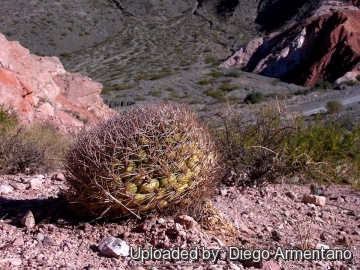 In habitat 2600 metres above sea level, province of Jujuy, Argentina. Photo by: Diego Armentano
In habitat 2600 metres above sea level, province of Jujuy, Argentina. Photo by: Diego Armentano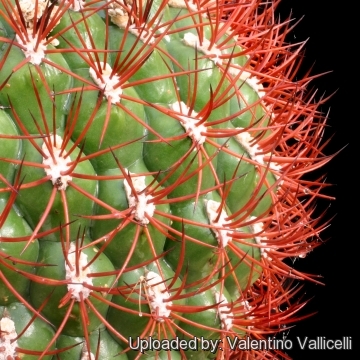 - Wet spines are red! Photo by: Valentino Vallicelli
- Wet spines are red! Photo by: Valentino Vallicelli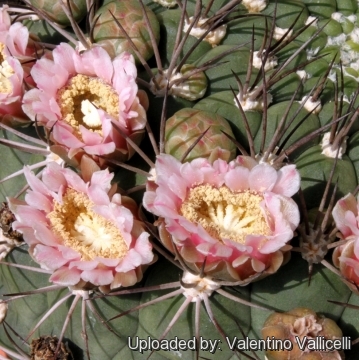 Gymnocalycium saglionis Photo by: Valentino Vallicelli
Gymnocalycium saglionis Photo by: Valentino Vallicelli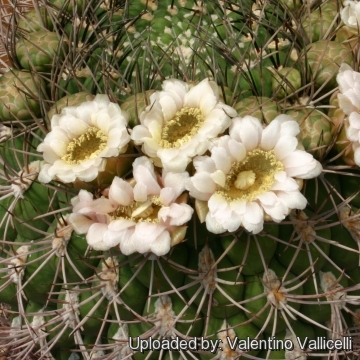 The flowers have a hard time coming through the dense mass of spines. Photo by: Valentino Vallicelli
The flowers have a hard time coming through the dense mass of spines. Photo by: Valentino Vallicelli Gymnocalycium saglionis Photo by: Cactus Art
Gymnocalycium saglionis Photo by: Cactus Art STO 87-23/2 (by Helmut Amerhauser, Franz Strigl, Hans Till) Agua Blanca to Pinchas, La Rioja, Argentina. 1350m. Photo by: Valentino Vallicelli
STO 87-23/2 (by Helmut Amerhauser, Franz Strigl, Hans Till) Agua Blanca to Pinchas, La Rioja, Argentina. 1350m. Photo by: Valentino Vallicelli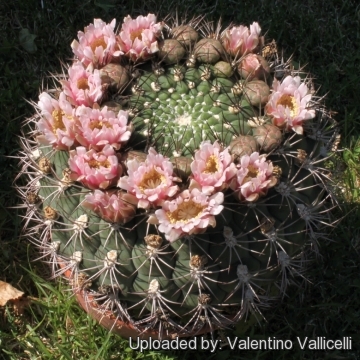 Gymnocalycium saglionis Photo by: Valentino Vallicelli
Gymnocalycium saglionis Photo by: Valentino Vallicelli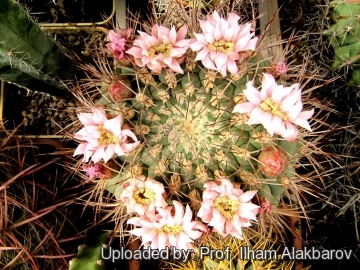 Gymnocalycium saglionis Photo by: Prof. Ilham Alakbarov
Gymnocalycium saglionis Photo by: Prof. Ilham AlakbarovCultivation and Propagation: Keep this plant almost dry in winter at a minimum temperature of 0°C, prefer a low pH compost otherwise growth will stop altogether. The plant tolerate extremely bright situations but are likely to suffer from sun scorch or stunted growth if over exposed to direct sunlight during the hottest part of the day in summer. Since they are big sized plants need plenty of space for their roots, repotting should be done every other year or when the plant has outgrown its pot.
This species makes a great landscape cactus in moderate climates.
Use and Trade: The fruits of this species are edible and used to make jam. This cactus is also used as an ornamental.
Propagation: Seeds (It don't produces offsets). Seed Collecting: Permit fruit to ripen, fruit must be significantly overripe before harvesting seed; clean and dry seeds
Your Photos
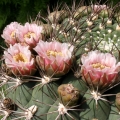
by Valentino Vallicelli

by Valentino Vallicelli

by Valentino Vallicelli
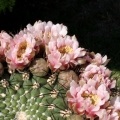
by Valentino Vallicelli






















